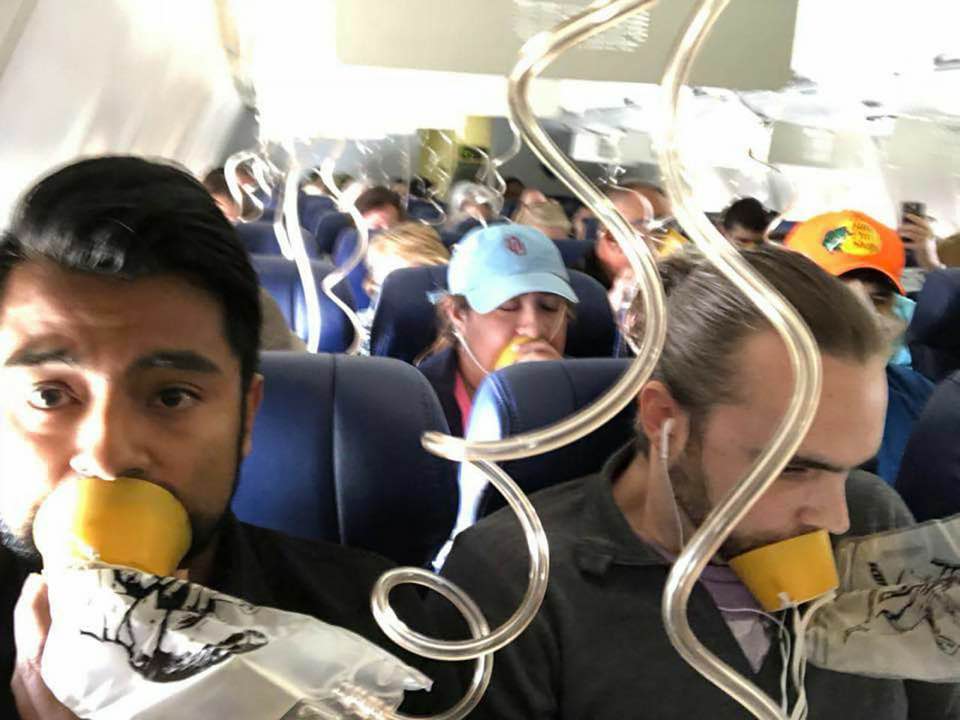- Joined
- Mar 27, 2011
- Messages
- 1,993
- Reaction score
- 2,651
I was reading this article about how most passengers in the recent Southwest flight that lost an engine + window were wearing their oxygen masks incorrectly:

This got me to thinking, according to the article, the plane depressurized at 30,000 feet. Clearly nobody is getting 100% FiO2 given their terrible non-rebreather technique. Why didn't anybody pass out from hypoxia?
The article also states that they descended to 10,000 feet within 5 minutes, which doesn't explain it. They also had a broken window, so no way to pressurize the plane.
Thoughts?
Southwest Airlines Flight 1380 suffered a major engine failure on Tuesday, forcing its pilot to make an emergency landing.
Shrapnel pierced the airplane's fuselage, blew out a window, and caused the cabin of the airplane to depressurize. One passenger died.
The pilot, Tammie Jo Shults, who used to fly US Navy fighter jets, guided the airplane, which took off from New York and was bound for Dallas, to a landing in Philadelphia.
Oxygen masks dropped from the cabin ceiling during the incident, according to a public Facebook post by Marty Martinez, a passenger on the flight.
Bobby Laurie/Twitter; Marty Martinez/Facebook
Bobby Laurie, a former flight attendant who now hosts a TV show, shared one of Martinez's photos on Twitter along with a reminder that people should cover their nose and mouth with an oxygen mask in an emergency.
"PEOPLE: Listen to your flight attendants!" Laurie said. "ALMOST EVERYONE in this photo from @SouthwestAir #SWA1380 today is wearing their mask WRONG."
Why you need oxygen if an aircraft cabin loses pressure
Flying at high altitudes with a hole in an airplane is, to put it lightly, dangerous.
At altitudes above 15,000 feet, people struggle to breathe and keep enough oxygen in their blood. They can lose consciousness within minutes — a condition called hypoxia.
Symptoms of hypoxia include "nausea, apprehension, tunnel vision, headaches, fatigue, dizziness, blurred vision, tingling sensations, numbness, and mental confusion," according to the Aircraft Owners and Pilots Association.
The problem isn't the percentage of oxygen in the air, which stays relatively constant at about 21% until about 70,000 feet — it's the lack of air pressure.
The correct way to wear an oxygen mask during an in-flight emergency.
Shutterstock
High pressure makes air dense, which helps force oxygen through lung tissue and into the bloodstream. Insufficient pressure lowers air density, thereby decreasing the amount of available oxygen.
Adding a flow of 100% oxygen helps counter this physiological problem. But you have to wear and use the mask correctly.
If you don't cover both your nose and your mouth with the mask, you may not get enough oxygen into your bloodstream, putting you at risk of losing consciousness.
How correctly wearing an oxygen mask could save your life — and those around you
The Southwest flight's engine failure happened when the plane was about 31,000 feet in the air, based on passenger reports.
Shults descended the airplane to an altitude of 10,000 feet shortly after, according to flight-tracking data from FlightRadar24.com, and landed the aircraft about 12 minutes after an emergency was declared.
According to a chart from AOPA on "time of useful consciousness," the passengers would have had about 30 seconds to get their masks on after the window blew open.
Aircraft Owners and Pilots Association
That flow of oxygen is crucial in emergencies, as passengers who are passed out won't be able to evacuate. And if there's any kind of fire or smoke condition, an unconscious neighbor slumped in an aisle could mean the difference between life and death. That's why masks are designed to deploy immediately.
Southwest public-announcement flashcards posted on Quizlet indicate passengers get these instructions before every takeoff:
"If needed, four oxygen masks will drop from the compartment overhead. To activate the flow of oxygen, pull down on the mask until the plastic tubing is fully extended. Place the mask over your nose and mouth and breathe normally.
"Secure the mask with the elastic strap. Although oxygen will be flowing, the plastic bag may not inflate. Continue wearing the mask until otherwise notified by a crew member. If you are traveling with children or anyone needing special assistance, put on your mask first."
An investigation into the incident by the National Transportation Safety Board is underway.
In response to Business Insider questions about Southwest's use of oxygen masks on Flight 1380, a company representative said via email: "We aren't ready to engage that level of detail at this time as we are focused on the immediate needs of the NTSB investigation."
Though concerns about flying and airplane safety permeate popular culture, it's much safer to travel by plane than by car.
The person who died on the Southwest flight on Tuesday was the first fatality in a US passenger airline accident in over nine years. In that time, there were almost 100 million US flights that carried billions of people, according to Bloomberg.

This got me to thinking, according to the article, the plane depressurized at 30,000 feet. Clearly nobody is getting 100% FiO2 given their terrible non-rebreather technique. Why didn't anybody pass out from hypoxia?
The article also states that they descended to 10,000 feet within 5 minutes, which doesn't explain it. They also had a broken window, so no way to pressurize the plane.
Thoughts?
